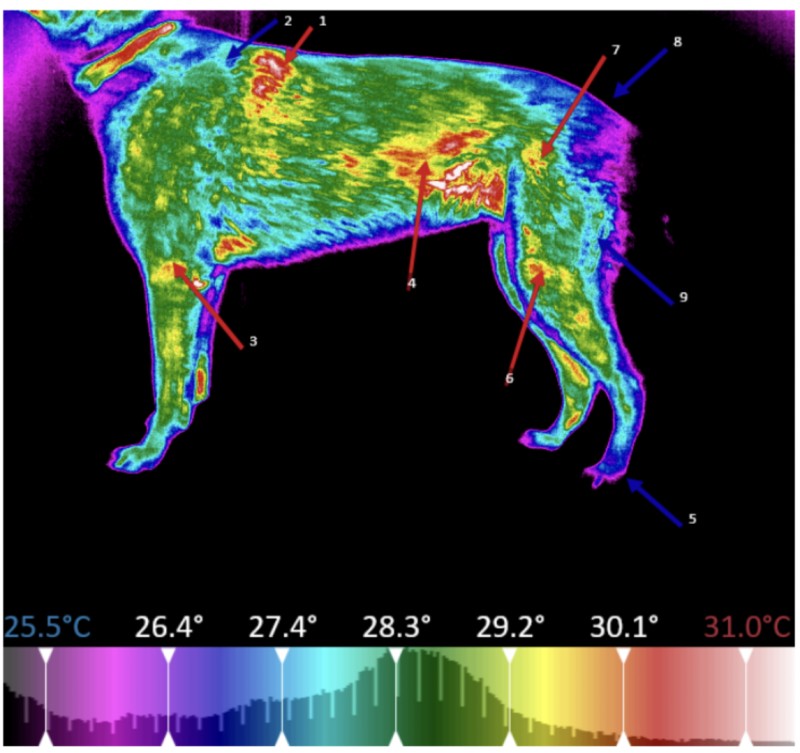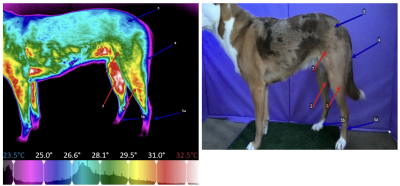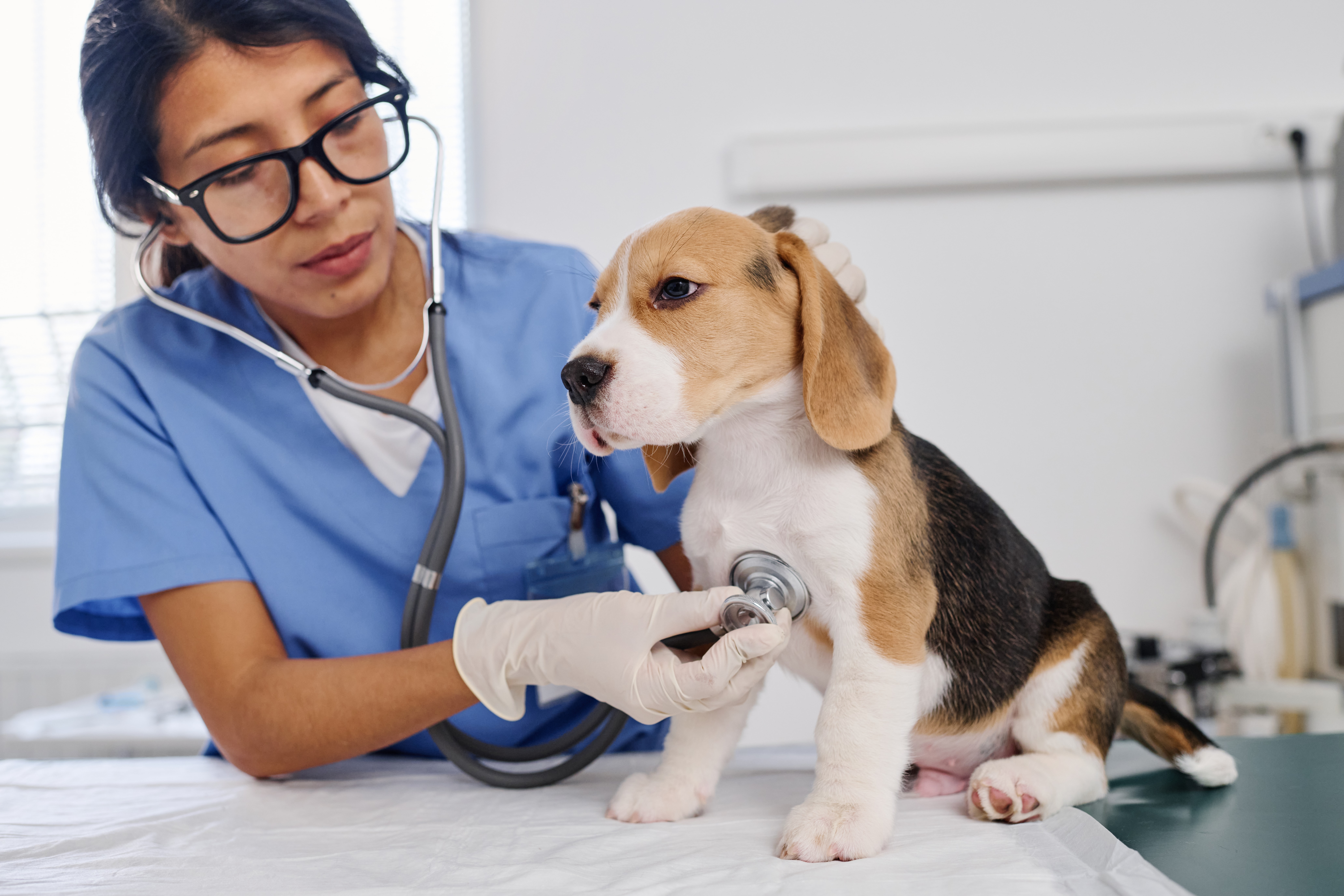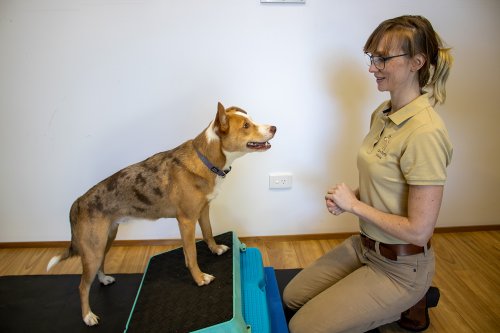Is My Dog In Pain? What to look for and what to do
Pain: an unpleasant sensory and emotional experience associated with actual or potential tissue damage, as described by experts, can be very subjective and—when we’re talking about dogs—at times almost invisible. Find out more about canine pain hidden in plain sight in this article.
Is Pain Driving Your Dog’s Behaviour?

Dogs are often known as being stoic, hiding their pain due to self-preservation instincts. In the wild, injured animals may attract the unwanted attention of potential predators, as pain and injury reduce the animal's ability to flee. Thus, hiding weaknesses is a strategy to protect their life.
But the question that many are now asking is: can we do more to identify pain in our pet dogs, canine athletes and working dogs? Are dogs still skilled at hiding their pain, or do we lack the skills to determine and remedy their ailments before they become debilitating?
A dog that limps, cries out in pain, has blood in their stool, or shows other apparent signs of pain is likely to be taken to their local veterinarian for a check-up, diagnosis, and treatment plan. These are all significant clinical signs that the body is unwell, but how much pain are our dogs living in daily? The Healing Vet, Dr Edward Bassingthwaighte, estimates that one in every two dogs suffers from silent pain!
Behavioural Issues Can Be Caused or Exacerbate by Pain
Sometimes owners first become aware of a problem when unwanted behavioural issues appear. One of the most overlooked driving factors behind many behaviour problems is pain.
Pain may present as either acute or chronic; it can be localised to a specific area – or systemic, affecting the whole body. Acute pain has a sudden onset and is most often caused by a trauma incident. These are, for example, injuries that can occur during training, rough play, or accidents.
Chronic pain can creep up slowly upon an individual, gradually worsening over time. This type of pain often goes unnoticed, subjecting dogs to extended suffering. Chronic pain can arise from poor biomechanics, lack of physical condition, postural misalignments and many other conditions, especially degenerative ones.
Are our pets hiding their pain, or are we not recognising the signs? Even though it may appear that our dogs are attempting to hide the more obvious signs that something is wrong, they readily show changes in behaviour when afflicted with silent pain. These changes may be subtle or, more so, a nuisance – such as increased barking; nevertheless, the owner should consider pain as an underlying factor when behavioural changes present in their dog.
For example, if a dog suffers from a toothache, it may avoid eating or chewing on that side of the mouth. Dogs in pain might seem tired and behave differently, perhaps avoiding touch. If your dog used to love long walks and suddenly now walks slowly, listlessly behind you, then you know something is not right, especially if such behaviour is repeated and shows signs of worsening.
How Do I Recognize My Dog's Pain?
Observing their pet’s daily activities allows pet owners to react more swiftly upon detecting changes in their dog’s physical, emotional or behavioural state. These observations and the owner's description of the dog's pain can assist veterinarians when examining the patient, potentially guiding them to a diagnosis earlier. An effective treatment plan can then be developed to both manage the pain and treat the underlying condition. Thus, the owner's role in detecting and healing pet pain is irreplaceable.
How a dog reacts to and tolerates, pain is very individual and dependent upon many things, including; personality, intensity and location of the pain. Canine therapists, especially those trained in Canine Osteopathy and Whole Energy Body Balance, are experts in detecting physical and emotional pain within dogs. However, there are physical signs that owners and handlers can pay attention to determine if their pet is in pain.

Physical Signs of Pain
Physical signs and changes in behaviour can occur independently or several of them at once. Dog owners should pay attention to any changes so that they can describe the changes to the veterinarian as well as possible. Here are some of the most common signs of pet pain.
Sudden Onset of Behavioural Issues
Any sudden unexplained change in behaviour warrants a visit to your general veterinarian.
The manifestation of pain within the body may affect the dog’s mood, tolerance, and well-being resulting in unexpected behaviours. Where usually, a dog may be calm, relaxed, and easy-going – when it experiences pain, the same dog may present with aggression or even reluctance to engage in activities it once loved. There is no rule about what outward behaviours a dog in pain will exhibit; they may seem listless or more tired. Whatever the change is, if it is sudden, pay attention to it and seek a diagnosis from your vet and treatment from your canine therapist.
Stiffness or Lameness
Stiffness is often observable when the dog transitions from standing to lying down or vice versa. If your dog tenderly lays one hip down and then lowers their front end, they likely have some level of somatic dysfunction. Early signs of osteoarthritis and joint pain present in this manner.
Arthritic pain is common in older dogs; this is due to the degenerative nature of the disease. The discomfort caused by inflammation in the joints may be more pronounced in cold weather or upon rising in the morning. It may also be accompanied by lameness or problems maintaining balance.
Dogs may present lame in one or more limbs, in either a stationary position, at the walk or whilst trotting. Lameness is indicated by the avoidance of bearing weight on a limb, head bobbing, or an altered stride – there may be many causes of lameness. Depending on the cause, treatment with manual therapies is often helpful.
Avoiding Touch
When a dog feels pain in a specific part of its body, it may be fearful of touch in this area, worried that the pain will increase. When the pain is high, or the dog's threshold for pain is low, they may show uncharacteristic signs of aggression when touched—even though they were previously perfectly fine with human touch and petting. Such behaviour occurs because they want to protect themselves from increased pain and avoid having the painful area touched.
Looking at or Licking a Particular Area
Licking, looking at or biting an area of their body can indicate a sore spot. This behaviour is a common instinctive reaction in many animals. If you notice your dog suddenly jerking and looking at a particular area on its body, it may be experiencing a sudden sharp pain from that area of their body. However, when the behaviour is repetitive, owners should take note and seek care for their dogs. Thermal imaging can help us identify the exact locations of inflammation, as seen in the image below; arrow 4 points to the inflamed area where this dog was fixating.

Appetite Change
As with humans, pain in dogs often leads to food reluctance and decreased appetite. Perhaps the dog will start to refuse all food or only certain types of food. For instance, refusal of hard or solid foods may indicate dental problems; the dog associates pain with this type of food and thus avoids eating it. Sometimes dogs will hold out for a more gourmet dinner option simply because they have realised that avoiding kibble results in a roast dinner being served.
If you notice a refusal of usual food, especially if it appears in parallel with other signs, react as soon as possible and find the cause of such behaviour.
Other Signs of Pain or Discomfort
Rolling onto their belly and pushing owners away
Refusing to climb stairs
Decreased activity
Excessive panting
Pacing and inability to settle
Irritability
Lack of interest in usual activities
If you notice one or more of these behaviours, pain is a possible cause. And as we have already mentioned, acute pain is often more visible because its cause is usually more apparent (external injury). But chronic pain is longer-lasting and worsens over time, which is often easier for pets to get used to and can show signs of discomfort much more subtly.
Click below to complete a brief pain inventory assessment of your dog.
Brief Pain InventoryCommon Causes of Hidden Pain
Dental Hygiene
The American Veterinary Dental College points out that, just like humans, dogs can suffer from periodontal disease, tooth decay, injured teeth, and other oral problems requiring a dental procedure. The first or early signs of dental disease is bad breath, which many pet owners often ignore by simply thinking that dogs have bad breath. Of course, we cannot expect mint freshness, but bad breath can be one of the first indicators of illness and one of the dogs' most common silent pains. Furthermore, these dental problems can lead to serious health issues beyond discomfort and bad breath.
Arthritic Pain
Arthritis is an inflammation of the joints and often occurs in older dogs (although this is not necessarily the rule) and causes pain, discomfort, and stiffness. Among the first signs of arthritis are difficulty getting up and down, stiff walking, lameness, and reluctance to climb stairs. These signs of pain can sometimes be subtle, and most dogs can experience discomfort for a long time before it becomes clear that there are health problems.
Biomechanical Dysfunction
Among the most common causes of pain are biomechanical dysfunctions. Such states can be caused and conditioned by different physical predispositions. For example, if the muscles are unevenly developed, they affect the dog's gait, creating uneven joint pressure. Joint pain can also occur during walking or running if the movements are limited in some way. Biomechanical dysfunctions can often be addressed with suitable exercises and stretches or through manual therapy.
What to do if I Think My Dog is in Pain?
When observing your dog, if you notice some of the signs of behaviour change, as discussed earlier, or open indicators of pain, it is important to react as soon as possible. However, always be sure to avoid getting bitten during the examination. Even if you are sure your dog will never bite, pain can cause unpredictable behaviour.
If the pain is obvious and severe, it may require veterinary care and emergency help. If, however, the pain is long-term or chronic, there are more detailed steps you can take to get the most precise picture of what's causing the pain. The recommended steps are as follows:
Physiological Assessment: Thermal Imaging Wellness Scan

Thermal imaging is a screening tool that can assist in detecting possible disease and pain sources. It captures temperature differences and displays the results in an informative visual image, clearly showing the places of dysfunction. Your veterinarian can use the thermal imaging wellness report to guide diagnosis or by your canine therapist to aid in the strategic delivery of treatments. Find out more about Thermal Imaging Wellness Scan and schedule an appointment.
Visit Your Vet to Discuss a Diagnosis

Once the Thermal Imaging report is generated, a copy is provided to the dog's owner. If significant findings are present, you may be advised to visit your veterinarian and discuss a diagnosis. Otherwise, it will be used to monitor the progress of your dogs over the course of their therapy; it allows therapists to see things they otherwise might not have noticed, ensuring treatments are tailored to your dog's specific needs according to its determined source of pain.
Consider Pain Medication
Once the cause of pain is understood, a treatment plan can be devised; it may include more severe actions such as surgery. Alternatively, your veterinarian may prescribe pain-relief medication. There are several types of drugs (for example, nonsteroidal anti-inflammatory drugs or opioids used for more severe pain). The veterinarian will choose the one that will be appropriate for your dog.
Some pain medications have side effects or cannot be used long-term. If your dog is on pain medication, consider consulting with a canine therapist who uses natural means to reduce pain, complementing the effects of the prescribed pain medication; you may find your dog can taper off or reduce its medicines under the guidance of your vet.
Book in With a Canine Therapist
A highly skilled canine therapist can assist your dog by increasing joint mobility, reducing fascial adhesions, and improving the natural flow of the body’s many systems. Pairing manual therapies with exercises to improve fitness, strength, flexibility, or condition may help your dog prevent or reduce pain. Customised exercise plans and tailored manual therapies assist in returning balance to the body and mind. Learn more about Canine Body Balance Services

Start Using Supplements
There are supplements available on the market that help improve dog health. One of the best supplements made from natural ingredients is Antinol. Each tiny capsule is made from a patented blend of fully traceable marine lipid oils from sustainable sources and is free from preservatives and fillers. Used daily, Antinol is a natural anti-inflammatory for joint and mobility support. Read more about it in on our page about Antinol Rapid.
Modifying the Environment to Prevent Pain
Preventing pain starts with providing a safe environment for our dogs; minor changes can significantly impact overall health. Consider the surfaces your dog typically moves around on; are they slippery? Is there bedding too warm, too cold, too hard, or too soft? Ideally, the dog should have access to no-slip surfaces and a range of areas they can rest depending on their needs.
Falling or jumping down are often associated with pain-inducing trauma incidents, so non-slip ramps can be utilised for transitioning in and out of cars, beds, or off of the couch. Ramps should be stable enough that the dog can safely walk up or down with ease. Training
Weather conditions can also have a significant impact on the severity of pain felt by the dog. Sustained cold weather constricts the blood vessels and decreases circulation, slowing the body’s ability to service itself and reducing joint and muscle range of motion. Whilst during high summer temperatures, swelling and inflammation become more prevalent, increasing pain. Therefore, keeping your pet warm in winter and providing a way to cool down in summer will help optimise their health and well-being.






Leave a comment